Following the launch of trove.scot in February 2025 we are now planning the retiral of some of our webservices. Canmore will be switched off on 24th June 2025. Information about the closure can be found on the HES website: Retiral of HES web services | Historic Environment Scotland
Baths (20th Century), Swimming Pool (20th Century)
Site Name Clydebank, Bruce Street, Public Baths & Swimming Pool
Classification Baths (20th Century), Swimming Pool (20th Century)
Canmore ID 301566
Site Number NS47SE 255
NGR NS 49557 70094
Datum OSGB36 - NGR
Permalink http://canmore.org.uk/site/301566
Ordnance Survey licence number AC0000807262. All rights reserved.
Canmore Disclaimer.
© Bluesky International Limited 2025. Public Sector Viewing Terms
- Correction
- Favourite

DP 077721
VIew along Bruce Street to Clydebank public baths and swimming pool, taken from ENE
Records of the Royal Commission on the Ancient and Historical Monuments of Scotland (RCAHMS), Edinbu
20/4/2010
© Crown Copyright: HES

DP 077732
Detail of broken pediment and coat of arms on pool hall of Clydebank public baths and swimming pool.
Records of the Royal Commission on the Ancient and Historical Monuments of Scotland (RCAHMS), Edinbu
20/4/2010
© Crown Copyright: HES

DP 077748
Interior. View looking along the length of the swimming pool, taken from south east.
Records of the Royal Commission on the Ancient and Historical Monuments of Scotland (RCAHMS), Edinbu
20/4/2010
© Crown Copyright: HES

DP 077762
Interior. View looking down stair to rear of pool hall.
Records of the Royal Commission on the Ancient and Historical Monuments of Scotland (RCAHMS), Edinbu
20/4/2010
© Crown Copyright: HES

DP 077796
Interior. View of tiled male bath salon on 1st floor of bath house.
Records of the Royal Commission on the Ancient and Historical Monuments of Scotland (RCAHMS), Edinbu
20/4/2010
© Crown Copyright: HES

DP 077803
Interior. View of a slipper bath within a cubicle of the female bath salon.
Records of the Royal Commission on the Ancient and Historical Monuments of Scotland (RCAHMS), Edinbu
20/4/2010
© Crown Copyright: HES

DP 077805
Interior. Elevated view looking along the length of the pool hall, taken from the south east
Records of the Royal Commission on the Ancient and Historical Monuments of Scotland (RCAHMS), Edinbu
20/4/2010
© Crown Copyright: HES

DP 077808
Interior. View looking along the curved roof structure and roof lights of the pool hall
Records of the Royal Commission on the Ancient and Historical Monuments of Scotland (RCAHMS), Edinbu
20/4/2010
© Crown Copyright: HES

DP 077733
Detail of broken pediment and coat of arms on pool hall of Clydebank public baths and swimming pool.
Records of the Royal Commission on the Ancient and Historical Monuments of Scotland (RCAHMS), Edinbu
20/4/2010
© Crown Copyright: HES

DP 077737
Interior. View looking along the central corridor through the bathing cubicles of the ground floor, female bath salon.
Records of the Royal Commission on the Ancient and Historical Monuments of Scotland (RCAHMS), Edinbu
20/4/2010
© Crown Copyright: HES

DP 077741
Interior. View looking across the main entrance hall of the bath house.
Records of the Royal Commission on the Ancient and Historical Monuments of Scotland (RCAHMS), Edinbu
20/4/2010
© Crown Copyright: HES

DP 077746
Interior. Detail of the balcony stair within the main pool hall.
Records of the Royal Commission on the Ancient and Historical Monuments of Scotland (RCAHMS), Edinbu
20/4/2010
© Crown Copyright: HES

DP 077752
Interior view looking along the length of the pool hall, taken from south east, Clydebank public baths and swimming pool.
Records of the Royal Commission on the Ancient and Historical Monuments of Scotland (RCAHMS), Edinbu
20/4/2010
© Crown Copyright: HES

DP 077760
Interior. Diagonal view across the upper level of the pool hall, taken from north west
Records of the Royal Commission on the Ancient and Historical Monuments of Scotland (RCAHMS), Edinbu
20/4/2010
© Crown Copyright: HES

DP 077780
Interior. View of tiled corridors leading to the Turkish Bath area of the bath house.
Records of the Royal Commission on the Ancient and Historical Monuments of Scotland (RCAHMS), Edinbu
20/4/2010
© Crown Copyright: HES

DP 077800
Interior. Detail of the balcony railings within the main pool hall.
Records of the Royal Commission on the Ancient and Historical Monuments of Scotland (RCAHMS), Edinbu
20/4/2010
© Crown Copyright: HES

DP 077727
Principal (SE) elevation of pool hall at Clydebank public baths and swimming pool
Records of the Royal Commission on the Ancient and Historical Monuments of Scotland (RCAHMS), Edinbu
20/4/2010
© Crown Copyright: HES

DP 077753
Interior view looking along the changing cubicles on the side balcony of the pool hall, Clydebank public baths and swimming pool.
Records of the Royal Commission on the Ancient and Historical Monuments of Scotland (RCAHMS), Edinbu
20/4/2010
© Crown Copyright: HES

DP 077761
Interior. View of rear stair linking ground and balcony levels within pool hall.
Records of the Royal Commission on the Ancient and Historical Monuments of Scotland (RCAHMS), Edinbu
20/4/2010
© Crown Copyright: HES

DP 077775
Interior. View looking along changing cubicles on pool hall balcony.
Records of the Royal Commission on the Ancient and Historical Monuments of Scotland (RCAHMS), Edinbu
20/4/2010
© Crown Copyright: HES

DP 077778
Interior. View looking up at the curved roof structure of the pool hall.
Records of the Royal Commission on the Ancient and Historical Monuments of Scotland (RCAHMS), Edinbu
20/4/2010
© Crown Copyright: HES

DP 077779
Interior. Detail of access steps into the swimming pool.
Records of the Royal Commission on the Ancient and Historical Monuments of Scotland (RCAHMS), Edinbu
20/4/2010
© Crown Copyright: HES

DP 077793
Interior. View of tiled room which formerly housed the turkish bath.
Records of the Royal Commission on the Ancient and Historical Monuments of Scotland (RCAHMS), Edinbu
20/4/2010
© Crown Copyright: HES

DP 077795
Interior. View of tiled corridor within the bath house.
Records of the Royal Commission on the Ancient and Historical Monuments of Scotland (RCAHMS), Edinbu
20/4/2010
© Crown Copyright: HES

DP 077809
Interior. View looking across the swimming pool, taken from the north west at poolside.
Records of the Royal Commission on the Ancient and Historical Monuments of Scotland (RCAHMS), Edinbu
20/4/2010
© Crown Copyright: HES

DP 077726
View of baths building and 1960's extension of Clydebank public baths and swimming pool, taken from SSE
Records of the Royal Commission on the Ancient and Historical Monuments of Scotland (RCAHMS), Edinbu
20/4/2010
© Crown Copyright: HES

DP 077734
Interior. General view of female slipper bath salon.
Records of the Royal Commission on the Ancient and Historical Monuments of Scotland (RCAHMS), Edinbu
20/4/2010
© Crown Copyright: HES

DP 077747
Interior. View looking along the length of the pool hall, taken from south east.
Records of the Royal Commission on the Ancient and Historical Monuments of Scotland (RCAHMS), Edinbu
20/4/2010
© Crown Copyright: HES

DP 077764
Interior. Diagonal view across the pool hall taken from north west
Records of the Royal Commission on the Ancient and Historical Monuments of Scotland (RCAHMS), Edinbu
20/4/2010
© Crown Copyright: HES

DP 077768
Interior. Detail of access steps in swimming pool.
Records of the Royal Commission on the Ancient and Historical Monuments of Scotland (RCAHMS), Edinbu
20/4/2010
© Crown Copyright: HES

DP 077773
Interior. View of stair leading to balcony from poolside.
Records of the Royal Commission on the Ancient and Historical Monuments of Scotland (RCAHMS), Edinbu
20/4/2010
© Crown Copyright: HES

DP 077777
Interior. View of access steps into swimming pool.
Records of the Royal Commission on the Ancient and Historical Monuments of Scotland (RCAHMS), Edinbu
20/4/2010
© Crown Copyright: HES

DP 077784
Interior. View of a cubicle within the 'Sunray Suite' of the bath house.
Records of the Royal Commission on the Ancient and Historical Monuments of Scotland (RCAHMS), Edinbu
20/4/2010
© Crown Copyright: HES

DP 077806
Interior. Elevated view looking down across the swimming pool, taken from the south east
Records of the Royal Commission on the Ancient and Historical Monuments of Scotland (RCAHMS), Edinbu
20/4/2010
© Crown Copyright: HES

DP 077723
Principal (SE) elevation of 1960's extension to Clydebank public baths and swimming pool
Records of the Royal Commission on the Ancient and Historical Monuments of Scotland (RCAHMS), Edinbu
20/4/2010
© Crown Copyright: HES

DP 077730
View of central pedimented bay of pool hall at Clydebank public baths and swimming pool.
Records of the Royal Commission on the Ancient and Historical Monuments of Scotland (RCAHMS), Edinbu
20/4/2010
© Crown Copyright: HES

DP 077749
Interior. View looking along the length of the main pool hall, taken from south east
Records of the Royal Commission on the Ancient and Historical Monuments of Scotland (RCAHMS), Edinbu
20/4/2010
© Crown Copyright: HES

DP 077750
Interior. View looking along the side wall and balcony changing cubicles of the pool hall, taken from east.
Records of the Royal Commission on the Ancient and Historical Monuments of Scotland (RCAHMS), Edinbu
20/4/2010
© Crown Copyright: HES

DP 077756
Interior. Detail of a changing cubicle on the balcony of the pool hall.
Records of the Royal Commission on the Ancient and Historical Monuments of Scotland (RCAHMS), Edinbu
20/4/2010
© Crown Copyright: HES

DP 077763
Interior. View of balcony and railings at the end of the pool hall.
Records of the Royal Commission on the Ancient and Historical Monuments of Scotland (RCAHMS), Edinbu
20/4/2010
© Crown Copyright: HES

DP 077766
Interior. View looking up to the curved roof structure and windows of the pool hall.
Records of the Royal Commission on the Ancient and Historical Monuments of Scotland (RCAHMS), Edinbu
20/4/2010
© Crown Copyright: HES

DP 077772
Interior view looking up at the balcony railings and changing cubicles from poolside, Clydebank public baths and swimming pool.
Records of the Royal Commission on the Ancient and Historical Monuments of Scotland (RCAHMS), Edinbu
20/4/2010
© Crown Copyright: HES

DP 077774
Interior. View looking down across pool hall from balcony.
Records of the Royal Commission on the Ancient and Historical Monuments of Scotland (RCAHMS), Edinbu
20/4/2010
© Crown Copyright: HES

DP 077791
Interior. View of tiling and cubicles within the sauna suite of the bath house.
Records of the Royal Commission on the Ancient and Historical Monuments of Scotland (RCAHMS), Edinbu
20/4/2010
© Crown Copyright: HES

DP 077794
Interior. View of modern sauna cabin within former location of a turkish bath
Records of the Royal Commission on the Ancient and Historical Monuments of Scotland (RCAHMS), Edinbu
20/4/2010
© Crown Copyright: HES

DP 077801
Interior. Detail of a changing cubicle on the balcony of the pool hall.
Records of the Royal Commission on the Ancient and Historical Monuments of Scotland (RCAHMS), Edinbu
20/4/2010
© Crown Copyright: HES

DP 077725
Principal (SE) elevation of baths building at Clydebank public baths and swimming pool
Records of the Royal Commission on the Ancient and Historical Monuments of Scotland (RCAHMS), Edinbu
20/4/2010
© Crown Copyright: HES

DP 077729
General view of Clydebank public baths and swimming pool, taken from S
Records of the Royal Commission on the Ancient and Historical Monuments of Scotland (RCAHMS), Edinbu
20/4/2010
© Crown Copyright: HES

DP 077731
Detail of main entrance door at Clydebank public baths and swimming pool
Records of the Royal Commission on the Ancient and Historical Monuments of Scotland (RCAHMS), Edinbu
20/4/2010
© Crown Copyright: HES

DP 077742
Interior. View of the main entrance door, the ticket office and the turnstile at the entrance to the bath house.
Records of the Royal Commission on the Ancient and Historical Monuments of Scotland (RCAHMS), Edinbu
20/4/2010
© Crown Copyright: HES

DP 077743
Interior. Detail of the turnstile within the main entrance hall of the bath house.
Records of the Royal Commission on the Ancient and Historical Monuments of Scotland (RCAHMS), Edinbu
20/4/2010
© Crown Copyright: HES

DP 077758
Interior. View looking along the side balcony of the pool hall.
Records of the Royal Commission on the Ancient and Historical Monuments of Scotland (RCAHMS), Edinbu
20/4/2010
© Crown Copyright: HES

DP 077765
Interior. View looking along the full length of the pool hall.
Records of the Royal Commission on the Ancient and Historical Monuments of Scotland (RCAHMS), Edinbu
20/4/2010
© Crown Copyright: HES

DP 077771
Interior. Detail of railing at poolside level.
Records of the Royal Commission on the Ancient and Historical Monuments of Scotland (RCAHMS), Edinbu
20/4/2010
© Crown Copyright: HES

DP 077776
Interior. View of main stair linking poolside and balcony within pool hall.
Records of the Royal Commission on the Ancient and Historical Monuments of Scotland (RCAHMS), Edinbu
20/4/2010
© Crown Copyright: HES

DP 077781
Interior. View looking along the remaining cubicles within the turkish bath.
Records of the Royal Commission on the Ancient and Historical Monuments of Scotland (RCAHMS), Edinbu
20/4/2010
© Crown Copyright: HES

DP 077790
Interior.View into an individual sauna cubicle.
Records of the Royal Commission on the Ancient and Historical Monuments of Scotland (RCAHMS), Edinbu
20/4/2010
© Crown Copyright: HES

DP 077797
Interior. View looking up into the roof structure of the male bath salon, at 1st floor level of the bath house.
Records of the Royal Commission on the Ancient and Historical Monuments of Scotland (RCAHMS), Edinbu
20/4/2010
© Crown Copyright: HES

DP 077799
Interior. View looking down the main stair of the bath house, from first floor level.
Records of the Royal Commission on the Ancient and Historical Monuments of Scotland (RCAHMS), Edinbu
20/4/2010
© Crown Copyright: HES

DP 077802
Interior. Detail of a surviving slipper bath within a cubicle in the female bath salon.
Records of the Royal Commission on the Ancient and Historical Monuments of Scotland (RCAHMS), Edinbu
20/4/2010
© Crown Copyright: HES

DP 077804
Interior. View looking along the rows of cubicles within the female bath salon.
Records of the Royal Commission on the Ancient and Historical Monuments of Scotland (RCAHMS), Edinbu
20/4/2010
© Crown Copyright: HES

DP 077735
Interior. View looking along the cubicle row within the ground floor, female bath salon.
Records of the Royal Commission on the Ancient and Historical Monuments of Scotland (RCAHMS), Edinbu
20/4/2010
© Crown Copyright: HES

DP 077738
Interior view of the entrance door to the female bath salon, Clydebank public baths and swimming pool.
Records of the Royal Commission on the Ancient and Historical Monuments of Scotland (RCAHMS), Edinbu
20/4/2010
© Crown Copyright: HES

DP 077745
Interior. View looking into the ticket office within the main entrance hall of the bath house.
Records of the Royal Commission on the Ancient and Historical Monuments of Scotland (RCAHMS), Edinbu
20/4/2010
© Crown Copyright: HES

DP 077751
Interior. View looking along the main pool hall, taken from south east
Records of the Royal Commission on the Ancient and Historical Monuments of Scotland (RCAHMS), Edinbu
20/4/2010
© Crown Copyright: HES

DP 077755
Interior. Detail of the changing cubicles on the balcony of the pool hall.
Records of the Royal Commission on the Ancient and Historical Monuments of Scotland (RCAHMS), Edinbu
20/4/2010
© Crown Copyright: HES

DP 077757
Interior. Diagonal view looking across the upper level of the pool hall, taken from east.
Records of the Royal Commission on the Ancient and Historical Monuments of Scotland (RCAHMS), Edinbu
20/4/2010
© Crown Copyright: HES

DP 077759
Interior. Diagonal view looking across the upper level of the pool hall. taken from the north west.
Records of the Royal Commission on the Ancient and Historical Monuments of Scotland (RCAHMS), Edinbu
20/4/2010
© Crown Copyright: HES

DP 077769
Interior. Detail of a bay of the balcony railings within the pool hall.
Records of the Royal Commission on the Ancient and Historical Monuments of Scotland (RCAHMS), Edinbu
20/4/2010
© Crown Copyright: HES

DP 077787
Interior. View of turkish bath entrance door, with stencilled lettering.
Records of the Royal Commission on the Ancient and Historical Monuments of Scotland (RCAHMS), Edinbu
20/4/2010
© Crown Copyright: HES

DP 077788
Interior. View of changing cubicles within the 'Sunray Suite' of the bath house.
Records of the Royal Commission on the Ancient and Historical Monuments of Scotland (RCAHMS), Edinbu
20/4/2010
© Crown Copyright: HES

DP 077789
Interior. View of individual cubicles within the sauna of the bath house.
Records of the Royal Commission on the Ancient and Historical Monuments of Scotland (RCAHMS), Edinbu
20/4/2010
© Crown Copyright: HES

DP 077798
Interior. View of tiled landing at the top of the main stair, at first floor level of the bath house.
Records of the Royal Commission on the Ancient and Historical Monuments of Scotland (RCAHMS), Edinbu
20/4/2010
© Crown Copyright: HES

DP 077722
General view of Clydebank public baths and swimming pool, taken from E
Records of the Royal Commission on the Ancient and Historical Monuments of Scotland (RCAHMS), Edinbu
20/4/2010
© Crown Copyright: HES

DP 077724
View of 1960's extension to Clydebank public baths and swimming pool, taken from SSE
Records of the Royal Commission on the Ancient and Historical Monuments of Scotland (RCAHMS), Edinbu
20/4/2010
© Crown Copyright: HES

DP 077728
View of pool hall at Clydebank public baths and swimming pool, taken from SSE
Records of the Royal Commission on the Ancient and Historical Monuments of Scotland (RCAHMS), Edinbu
20/4/2010
© Crown Copyright: HES

DP 077736
Interior. View of a bath within a cubicle of the ground floor, female bath salon.
Records of the Royal Commission on the Ancient and Historical Monuments of Scotland (RCAHMS), Edinbu
20/4/2010
© Crown Copyright: HES

DP 077739
Interior. View looking through the main door into the female bath salon.
Records of the Royal Commission on the Ancient and Historical Monuments of Scotland (RCAHMS), Edinbu
20/4/2010
© Crown Copyright: HES

DP 077740
Interior. View of the main stair leading up to the first floor from the main entrance hall.
Records of the Royal Commission on the Ancient and Historical Monuments of Scotland (RCAHMS), Edinbu
20/4/2010
© Crown Copyright: HES

DP 077744
Interior. Detail of the maker's plate on the turnstile at the main entrance.
Records of the Royal Commission on the Ancient and Historical Monuments of Scotland (RCAHMS), Edinbu
20/4/2010
© Crown Copyright: HES

DP 077754
Interior. View looking along the side balcony of the pool hall.
Records of the Royal Commission on the Ancient and Historical Monuments of Scotland (RCAHMS), Edinbu
20/4/2010
© Crown Copyright: HES

DP 077767
Interior. Detail of the access steps into the swimming pool.
Records of the Royal Commission on the Ancient and Historical Monuments of Scotland (RCAHMS), Edinbu
20/4/2010
© Crown Copyright: HES

DP 077770
Interior. View looking up at the balcony railings from poolside.
Records of the Royal Commission on the Ancient and Historical Monuments of Scotland (RCAHMS), Edinbu
20/4/2010
© Crown Copyright: HES

DP 077782
Interior. View looking along a tiled corridor within the bath house.
Records of the Royal Commission on the Ancient and Historical Monuments of Scotland (RCAHMS), Edinbu
20/4/2010
© Crown Copyright: HES

DP 077783
Interior. View into the 'Sunray Suite' of the bath house.
Records of the Royal Commission on the Ancient and Historical Monuments of Scotland (RCAHMS), Edinbu
20/4/2010
© Crown Copyright: HES

DP 077785
Interior. View of sunbeds within the 'Sunray Suite' of the bath house.
Records of the Royal Commission on the Ancient and Historical Monuments of Scotland (RCAHMS), Edinbu
20/4/2010
© Crown Copyright: HES

DP 077786
Interior. View of cubicles within the turkish bath of the bath house.
Records of the Royal Commission on the Ancient and Historical Monuments of Scotland (RCAHMS), Edinbu
20/4/2010
© Crown Copyright: HES

DP 077792
Interior. View of tiled room which formerly housed the turkish bath
Records of the Royal Commission on the Ancient and Historical Monuments of Scotland (RCAHMS), Edinbu
20/4/2010
© Crown Copyright: HES

DP 077807
Interior. Elevated view looking diagonally across the pool hall, taken from the south east
Records of the Royal Commission on the Ancient and Historical Monuments of Scotland (RCAHMS), Edinbu
20/4/2010
© Crown Copyright: HES
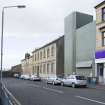
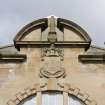
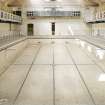
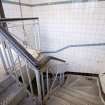
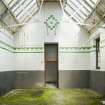
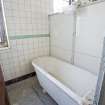
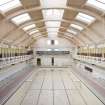
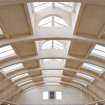
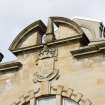

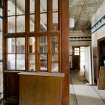
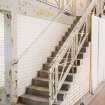
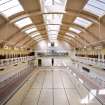
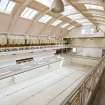

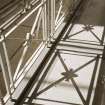
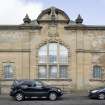
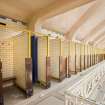
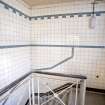
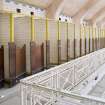
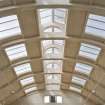
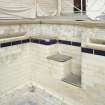
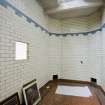
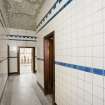
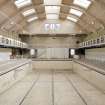
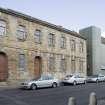

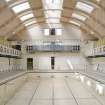
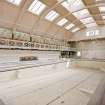
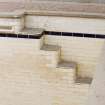
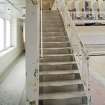

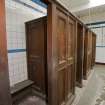
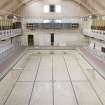
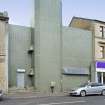
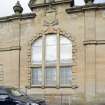
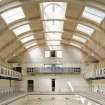
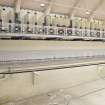
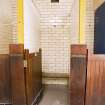
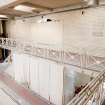
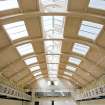
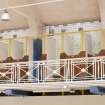

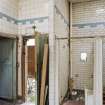
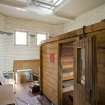
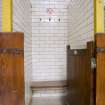

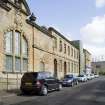

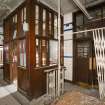
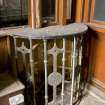

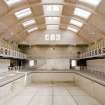
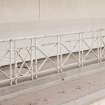
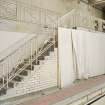
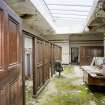
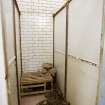
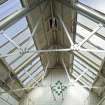
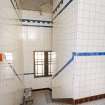
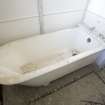
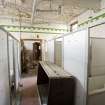

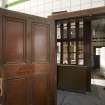
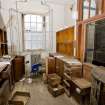
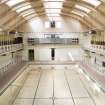
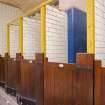
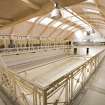
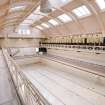

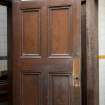
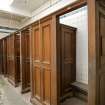
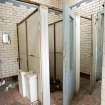
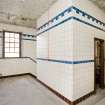
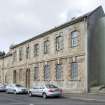

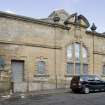

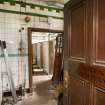
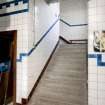
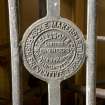
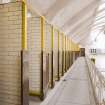
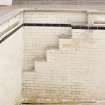
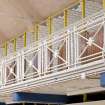
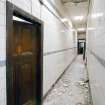
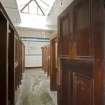
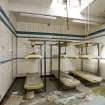
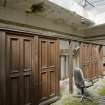
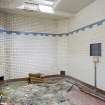
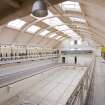
- Council West Dunbartonshire
- Parish Old Kilpatrick (Clydebank)
- Former Region Strathclyde
- Former District Clydebank
- Former County Dunbartonshire
Stylised Baroque Public Baths with adjoining 3-bay Swimming Pool to left (currently disused, 2009). Sandstone ashlar. Base course, band course, cornice. Rusticated, key-stoned openings. Public Baths with round-arched entrance openings and segmental arched window openings to ground. Bracketted cills to ground; narrow aprons to upper storey windows. 1960s tiled blank extension to right.
This is a good example of a now rare building type of public baths with an adjoining swimming pool complex. Once a relatively common building type in urban Scotland, public baths have become obsolete and modern leisure centres have largely replaced traditional swimming pools. It is an important streetscape feature and it was purposefully designed to match the style of the earlier, 1902 Municipal Buildings in Dumbarton Roadby the Glasgow architect James Miller. Together, the buildings form the major part of a complete block and form a coherent civic heart in Clydebank Public baths and swimming pools grew in popularity particularly in the second half of the 19th century and most of the surviving ones date from this period; some with intricately decorated interiors. Many people had no access to running water in the home and public health was becoming an increasingly important issue. In 1846, the Act to Encourage the Establishment of Public Baths was passed and the majority of public baths began to be built after this time. Built in the 1930s, this is a relatively late example and probably indicates that there were still a significant number of homes in Clydebank at this time with no bathing facilities. The Bruce Street Baths was designed to replace the nearby Hall Street Baths (now demolished) which were becoming too small. The plans were approved by the Council in 1929 and the baths were opened in 1932. It originally had a variety of facilities, including Turkish Baths, Russian Vapour Baths, a laundry and a massage room. (Historic Scotland)







